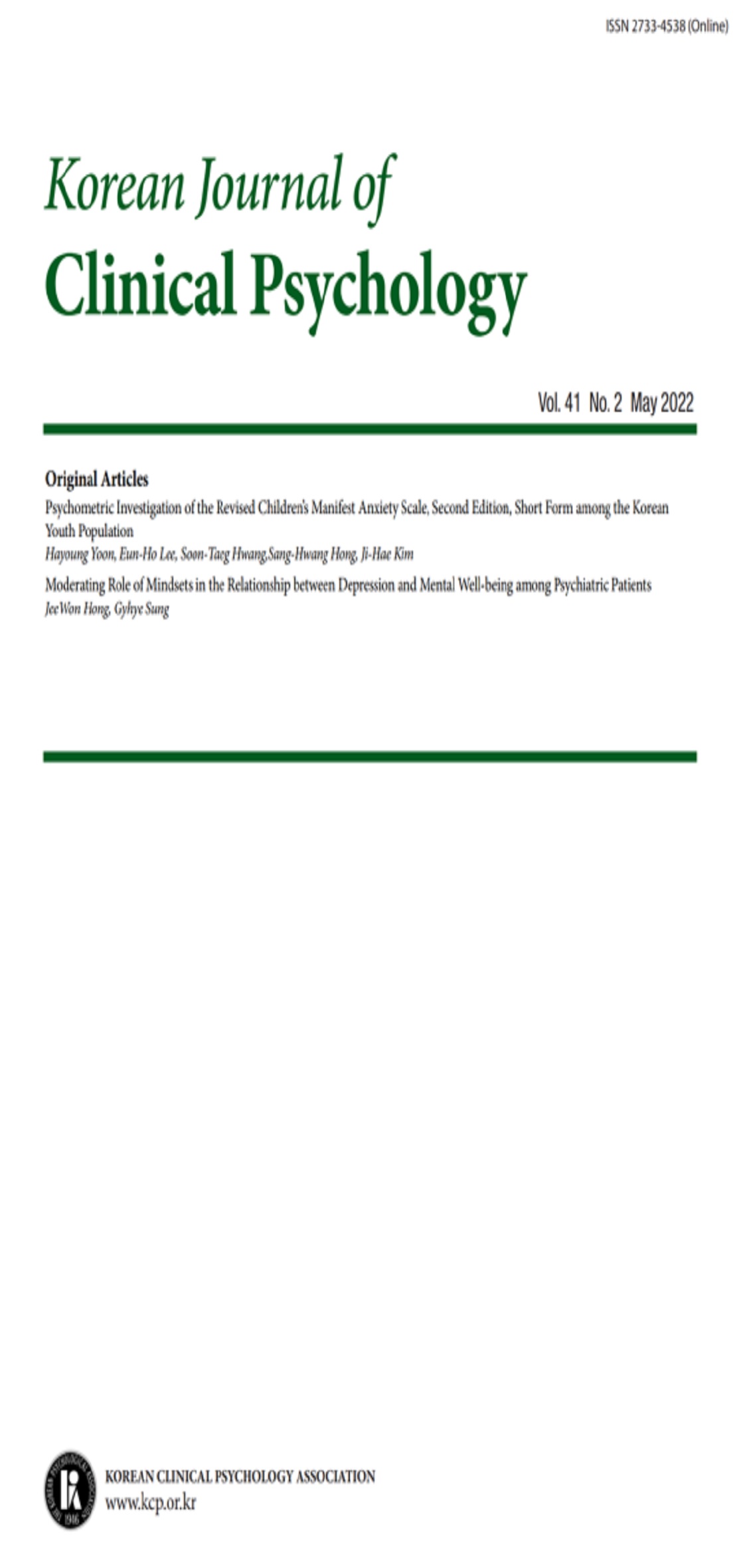open access
메뉴
open access
메뉴 E-ISSN : 2733-4538
E-ISSN : 2733-4538
본 연구에서는 초등학교 3학년-중학교 3학년에게 실시 가능한 또래 상호작용에 대한 자기제시 기대를 측정하는 척도를 개발하고 신뢰도와 타당도를 알아보고자 하였다. 또래 상호작용에 대한 자기제시 기대 척도는 자기제시 능력에 대한 기대와 자기제시 결과에 대한 기대로 구분하여, 선행 연구를 토대로 자기제시 능력에 대한 기대를 측정하는 20개의 예비문항과 자기제시 결과에 대한 기대를 측정하는 15개의 예비문항을 선정하였다. 연구대상은 초등학교 4-6학년 397명, 중학교 1-3학년 402명이었다. 요인분석 결과, 자기제시 기대 척도는 자기제시 결과 기대, 자기제시 능력 기대-이성 상황, 자기제시 능력 기대-동성/집단 상황의 세 요인으로 구성되어 있었다. 자기제시 기대 척도는 내적 일관성의 측면에서 신뢰도가 양호하였고 관련 척도와의 상관분석 결과 수렴 타당도가 지지되었다. 본 연구의 의의와 제한점에 대해서 논의하였다.
This study was performed to develop a Self-Presentational Expectancy Scale for Peer Interaction(SPES-PI) with 4th through 9th grades and to confirm its reliability and validity. SPES-PI was comprised of expectancy of self-presentational ability and expectancy of self- presentational outcome. The data of preliminary 20 items assessing expectancy of self-presentational ability and preliminary 15 items assessing expectancy of self-presentational outcome were collected from previous researches. Participants were 397 students in 4th through 6th grades and 402 students in 7th through 9th grades. The results of factor analysis indicated that SPES-PI was composed of 3 factors: Expectancy of self-presentational outcome, Expectancy of self-presentational ability-opposite sex situations, Expectancy of self-presentational ability-same sex/group situations. The internal consistency of SPES-PI was found to be reliable and convergent validity was established through correlational analysis with related scales. Implications and limitations of this study were discussed.
(2000) 아동 및 청소년의 우울증상에 대한 대인표상의 매개효과, 연세대학교
(2001) 또래의 괴롭힘이 청소년기 사회불안에 영향을 미치는 기제, 연세대학교
(2003) 청소년기 사회불안의 발생과 유지의 심리적 기제 I 행동억제기질, 부모양육태도 및 외상경험의 영향,
(1997) 기질 및 또래 지지가 청소년의 자기평가에 미치는 영향 단기 종단적 패널 연구, 연세대학교
(1986) Children's understanding of social anxiety,
(1980) Strategic interactions in early adolescence Handbook of adolescent psychology,
(1994) Ages of onset of psychiatric disorders in a community population of older adolescents Journal of the American Academy of Child and Adolescent Psychiatry,
(1998) Social anxiety in children with anxiety disorders:Relation with social and emotional functioning,
(1988) Manual for the self-perception profile for adolescents, University of Denver
(1989) An unwillingness to act and self-efficacy in shyness Journal of Personality,
(2003) List of social situation problems Reliability and validity in ad adolescent spanish-speaking sample Journal of Psychopathology and Behavioral Assessment,
(1991) Considering cognition in anxiety-disordered children,
(1998) Manual for the social anxiety scales for children and adolescents,
(1993) Social anxiety scale for children-revised:Factor structure and concurrent validity,
(1992) DSM III-R anxiety disorders in children Journal of the American Child and Adolescent Psychiatry,
(2001) Social anxiety as an early warning system A refinement and extension of the self-presentation theory of social anxiety From social anxiety to social phobia,
(1986) and inhibition in interpersonal encounters Journal of Social and Clinical Psychology,
(1988) Self-presentational concerns and social anxiety:The role of generalized impression expectancies,
(1999) Social anxiety in adolescents and appraisal of negative events Specificity or generality of bias,
(1991) Construing others' reactions to the self,
(1992) Development and validation of measures of maternal and self representations in school-age children Manuscript in preparation,
(1985) Foundations of the self in social life, Mc Graw-Hill Company
(1982) Social anxiety and self-presentation:A conceptualization and model,
(1996) The Anxiety Disorders Schedule for Children,
(1999) social outcomes and cognitive features of childhood social phobia Journal of Abnormal Psychology,
(1982) Assessment of children's self-efficacy for social interactions with peers,
